
Week #3 Organized Home Challenge
Organize Pantry, Spices & Food
This week's challenge is to organize pantry, spices, and other food storage areas so you can easily find what you need, and keep things fresh and safe from pests.
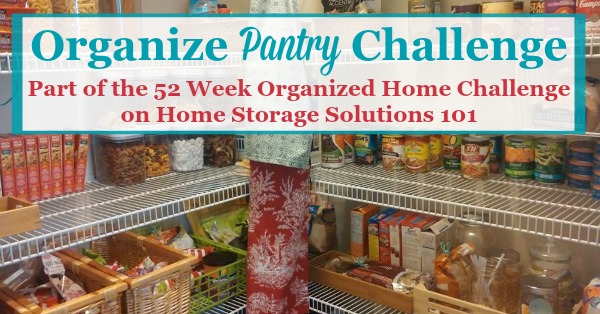
You will need to do this challenge whether your home has a dedicated pantry space or not, because although I'm using the term "pantry" the challenge is really about organizing food storage areas, and everyone stores some food in their home.
If you're lucky enough to have a space dedicated for this function great. If not, you just have to be more creative with your cabinet and other space in your kitchen or other areas of your house to store things for your family to eat.
Are you new here? The Organize Pantry, Spices & Food Challenge is part of the 52 Weeks To An Organized Home Challenge. (Click the link to learn how to join us for free for future and past challenges if you aren't already a regular reader).
Step 1: Declutter And Get Rid Of Expired Food Items
The first step in the Organize Pantry Challenge is to declutter your food storage areas, getting rid of things that don't belong in them and also getting rid of expired or old food, or food you know you and your family will not eat.
I did this recently, and was embarassed to find some really old stuff lurking in the back of my pantry. After I cleared out all the old stuff though I had so much more room, and it was very freeing.
To do this step take everything out of the pantry or other food storage areas (and if you've got multiple places you've been storing stuff this is even more important) and look at each item, making a decision of whether to toss it or keep it.
To help you know what to keep versus toss here's a free printable pantry food storage chart providing guidelines about the shelf life of common pantry items.
If the item is unopened and not expired, but you know you'll never eat it please donate it to a food pantry. One annual food drive I like to donate to is Stamp Out Hunger Food Drive which is each May, but obviously you can donate to local food pantries any time of year. In fact I've written an article listing the most needed food and non-food items that food pantries need that you can also use for reference.
If, when you do this step you realize you have a lot of food to eat, I suggest participating in the Eat From The Pantry & Freezer Challenge over the next two weeks, while you're simultaneously organizing your pantry and then next week, in Week #4 of the Challenge, organizing your freezer and refrigerator.
This simple challenge, which you can read more about by clicking the link, will help you clear off your shelves, eliminate food waste, and to save some money on groceries by ensuring you eat the items you've already purchased.
It's a great way to declutter your food storage areas the old-fashioned way! (You can also check out the Eat From The Freezer & Pantry Challenge Hall of Fame here to see the results other participants have had when doing the challenge.)
For more detailed step by step directions on how to declutter your pantry or food cupboards check out my article about it at the link.
Step 2: Categorize What You've Got Left
The next step in the Organize Pantry challenge is to categorize the food that you've got left. Here are some common major categories, but you should categorize things the way they make sense to you, and also depending on what your family likes to cook and eat.
- Dry goods, such as flour, sugar, etc.
- Canned goods, and jars
- Dried food, such as pasta, rice, beans and grains
- Boxed items, such as cereal and crackers, and also mixes
- Spices
- Beverages, including tea and coffee (not yet in the refrigerator)
- Root vegetables, such as potatoes and onions which are not stored in the refrigerator or freezer (you can get more information about fresh vegetable storage here)
- Pet food and treats (see the Organize Pet Supplies Challenge for more information)
Once you categorize everything and place like items together you may realize you have several duplicates of certain items. That is fine if you will use them before they go bad, but you may also realize you've got way too much of a particular item and can get rid of even more.
Step 3: Make A Pantry Inventory So You Know What You've Got From Now On
The next step in the Organize Pantry Challenge is to use the pantry list I've created (or one you create yourself) to inventory the food you've got left.
If you've kept the food and haven't gotten rid of it in one of the steps above, then I am presuming that you actually plan to eat this food at some point before it goes bad. To make sure you do that create an inventory system so you can plan meals to use these ingredients.
In addition, using a list like this from now on will keep you organized in the future because you will not run out of staple items anymore. If you use an item regularly, and it has a long shelf life, your goal should be to have at least two of them at all times in your home. The one in use and the one ready to be used as soon as you finish the other. When you get the spare make sure to write down on your grocery list to pick up another at the store. You'll never run out of staples this way!
Obviously, not everything is a good candidate for this system, such as things which go bad quickly. However, it is a wonderful system for certain non-perishables, and not only food but also for items like toiletries and paper supplies, such as paper towels and toilet paper.
I provided a bit more instruction on how to use this pantry inventory on the page itself which contains this free printable, so be sure to read that when you print out your sheet.
Please note I don't want you to get too caught up on the inventory, and making a very meticulous list. Instead, go with broad categories and provide only as much detail as necessary to make it useful and functional, instead of getting bogged down counting grains of rice. Your goal is to organize pantry space, so don't lose sight of that.
Step 4: Organize And Containerize Your Food
Now that you've got everything categorized and inventoried, now is the time in the Organize Pantry Challenge where you put everything back away in your pantry or other food storage space(s).
If you can put everything together in one space that's great, such as if yoy've got a walk-in pantry, but if you've got to spread things out throughout the house because of lack of large amounts of central storage space in your kitchen that's fine too. Just make sure you choose cool dry areas, and not those which have wide temperature variations since this will cause food to spoil much more quickly.
Group Items By Category Within Your Pantry
Just like with the Kitchen Cabinet Organization Challenge last week, when we considered the "zones" in our kitchens, we need to consider that same issue this week during the Organize Pantry Challenge.
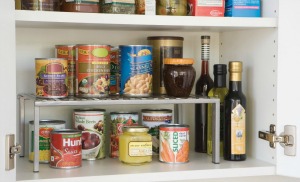 If you've got tall pantry shelves use expandable
If you've got tall pantry shelves use expandable
shelves to make more room for storage
[Available on Amazon.com]
Think about the zones in your pantry, and what can go where. I suggest grouping items in your pantry, to the extent possible, in the same way you categorized them earlier in the challenge. This will generally keep like items together, making things easy to find and get to when needed.
Try to place bulky items at mid-height for ease of getting them off the shelves. Place lighter items up high, where they are easy to get off shelves without fear of falling and hurting anything, and cans and jars at a mid to lower level. Obviously, the things you use most frequently need to be given the easiest access.
If you've got extra space in your pantry after placing all your food in there, you can use some of the extra room to hold seldom used appliances, pots and pans, etc., such as on high shelves to clear counter and cabinet space.
Location Of Snacks In Homes With Kids
The one thing I recommend being in a category by itself are snacks, especially if you've got kids. Where you place your snacks in your pantry, as part of the Organize Pantry Challenge, really depends on your family situation. If you've got young kids you may want to place snacks up high where they can't reach them.
On the other hand, perhaps you have older, trustworthy kids. In that case you may want a bin of healthy snacks within easy reach to encourage healthy snacking, and only have the occasional less-healthy treats in a more out of the way location. This allows you to let them help themselves without you having to assist every single time they want something. You decide what works best for your family.
Further, both adults and kids may benefit from having some fruit out in the kitchen, such as on the kitchen counters or kitchen table, in a fruit bowl. This reminds everyone to eat some fresh produce instead of something else.
You can get information about what fruit can be kept out at room temperature, on the counter, here, in this article about fresh fruit storage.
Lunch Packing Station: To Make Packed Lunches For Work & School Easier
If you or someone in your family needs to pack lunches for work or school each day, I suggest creating a specific section of your pantry (and a separate section of your refrigerator) for use as a lunch packing station.
Organizing, and prepping ahead, some or all of your lunches components will make the process of packing each day's lunch easier and less of a hassle.
Here's my article about how to organize a station to pack lunches for work or school.
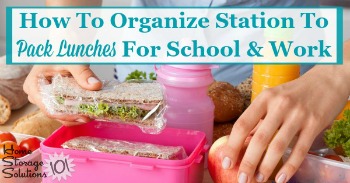
Containerize Much Of Your Food For Beauty, Function And Controlling Pests
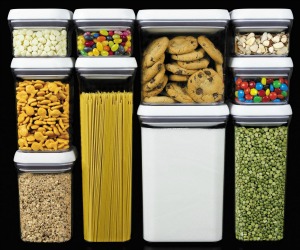 Oxo Good Grips 10 piece POP food container set
Oxo Good Grips 10 piece POP food container set
[Purchase on Amazon.com]
We've all seen pictures of beautiful pantries with all the food in storage canisters or other containers and drooled just a little. Reminder: Your pantry doesn't have to look that beautiful to be functional, but I am a HUGE fan of containers for much of your food.
The reason you don't want open food containers in your pantry is because they attract pests, such as insects and rodents. Trust me, I live a stone's throw from corn fields -- mice love open food containers, or even closed boxes and packages that aren't sealed up. (You can read my article with more food storage safety rules here.)
Because of the "mouse incident" in our house a few years ago I'm probably more of a stickler for this than some, but we keep all the food we can in plastic bins, with lids on them, to deter pests. I just group things into categories and it keeps things organized and safe at the same time. If you aren't as concerned about pests in your area you still may want to consider storage baskets for grouping like items together as part of the Organize Pantry Challenge just to keep things together and easily accessible.
I will note, however, that root vegetables, such as potatoes and onions need to "breathe" so you can't put them in a closed container.
Labels Are Your Friends
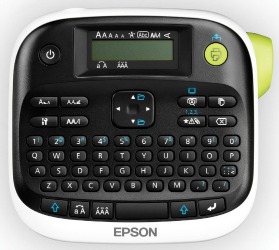 A label maker can help you neatly organize
A label maker can help you neatly organize
many areas of your home
[Click here to purchase on Amazon.com]
Whether you containerize or not in your pantry, labels are your friend. Part of the Organize Pantry Challenge, therefore, is to label either the containers or the shelves of your pantry to help with storage and organization. You can use either a label maker, such as the one shown on the right, a permanent marker, or get crafty with it, whatever you have time and desire to do.
First, labels are important if you take things out of the package so there is no doubt what you've got in there. You don't want to mistake salt for sugar, or baking soda for baking powder, for instance.
Please note if you take things out of their package for storage you may want to note somewhere the expiration or use by date for the food product too, so you use it before it goes bad, or know when to throw it out.
Second, labeling shelves or containers holding a category of items is an excellent way to make sure it is easy for you (and other family members) to put things away in the right place, or find something again easily. After thr Organize Pantry Challenge is completed the goal is for you to be able to have any family member unload the groceries into the pantry without assistance, because the labels will tell them where to put things.
Follow The Last In, Last Out Rule
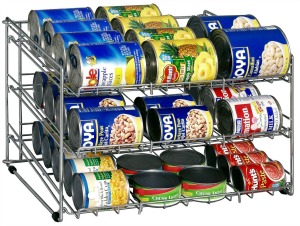 A can rack is a simple way to easily follow the
A can rack is a simple way to easily follow the
last in, last out rule [Available on Amazon.com]
Make sure when you're doing the Organize Pantry Challenge that you place things in your pantry in such a way that you're following the last in, last out rule. This is important for all foods, but especially is a good rule for canned and jarred foods.
The best way to explain this rule is with an example. When putting away jarred spaghetti sauce from the grocery store place the newly purchased jars at the back of the section of pasta sauces, moving the older jars closer to the front. Then, when you're ready to use one just grab the one up front.
This method makes sure you always use up the older food first, and don't leave one jar of sauce lingering so long in the back of the pantry that it expires before you ever use it.
Please note that if you use a lot of canned goods, a can organizer (such as the one shown to the left) will naturally help you use this rule by the way it is designed to load cans.
Also, if you do have lots of canned food, check out these can storage ideas and solutions.
Spice Storage And Organization
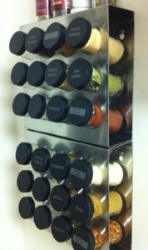 Spice rack
Spice rack
[Purchase on Amazon.com]
Lots of people get a bit carried away, in my opinion, with organzing their spices. There are many cute and awesome looking spice racks and organizers available that can make us feel like we're Alton Brown or another gourmet cook, but they shouldn't be a high priority if you've got lots of other organizing to do first, unless you use your spices all the time.
The important thing, whether you splurge on a spice organizer now or not, is to keep your spices in well labeled airtight jars or tins, and keep them where they're handy (but not too close to the heat). Further, unless you use a lot of a particular spice quickly, then it is best to buy your spices in small amounts, even if the cost per unit is higher, since they tend to lose flavor quickly and need to be replaced often.
A simple spice rack (such as the one shown to the left) or a drawer for your spices may be all you really need. Truly consider how many spices you have, and don't buy or use something either too big or too small for the amount of spice containers you truly use, on a regular basis.
You can get more ideas in the organizing and storing spaces hall of fame where readers share how they've done it in their own homes.
Step 5: Consider These Pantry, Spice And Food Storage Solutions
When you're doing step 4 of the Organize Pantry Challenge consider some of these pantry storage solutions to help you get the job done. Which ones will work best for you depend on your kitchen's layout, your personal preferences, and what your family eats and cooks on a regular basis.
- Plastic or glass caninsters with locking lids, and seals to keep in freshness (ideally clear to see contents inside)
- Storage baskets or tubs, with or without lids
- Can organizers (such as the one suggested above)
- Lazy susans or turntables (see to the right)
- Plastic bins to group like items (nice if they are pull out, but not necessary)
- Spice racks or organizers (many varieties, such as for the wall, over the door, cabinet, shelves, magnetic, etc.)
- Over the door rack, to increase storage space on the inside of your pantry door
- Shelf expanders or organizers, to stack more things and increase shelf space
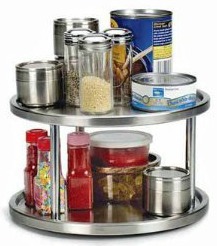 Stainless steel lazy Susan
Stainless steel lazy Susan
[Available on Amazon.com]
Listen To Taylor's Video Tips For This Week's Organized Home Challenge & Declutter 365 Missions
Do you want more in-depth tips and instructions for how to do this week's missions and challenge all about your pantry and food cupboards? If so, I've got recorded video tips from me, Taylor, from the video archives in the Declutter 365 Premium group, all about this week's challenge and missions.
These video tips are available on demand in the archives, once you're a member of the group.
In Week #3's video I discussed the following topics, among others:
- Pros and cons of food stockpiling
- Tips for decluttering food, plus dealing with the guilt of "food waste"
- Eat from the Pantry & Freezer Challenge
- Tips to organize your pantry
- Declutter 365 missions for week
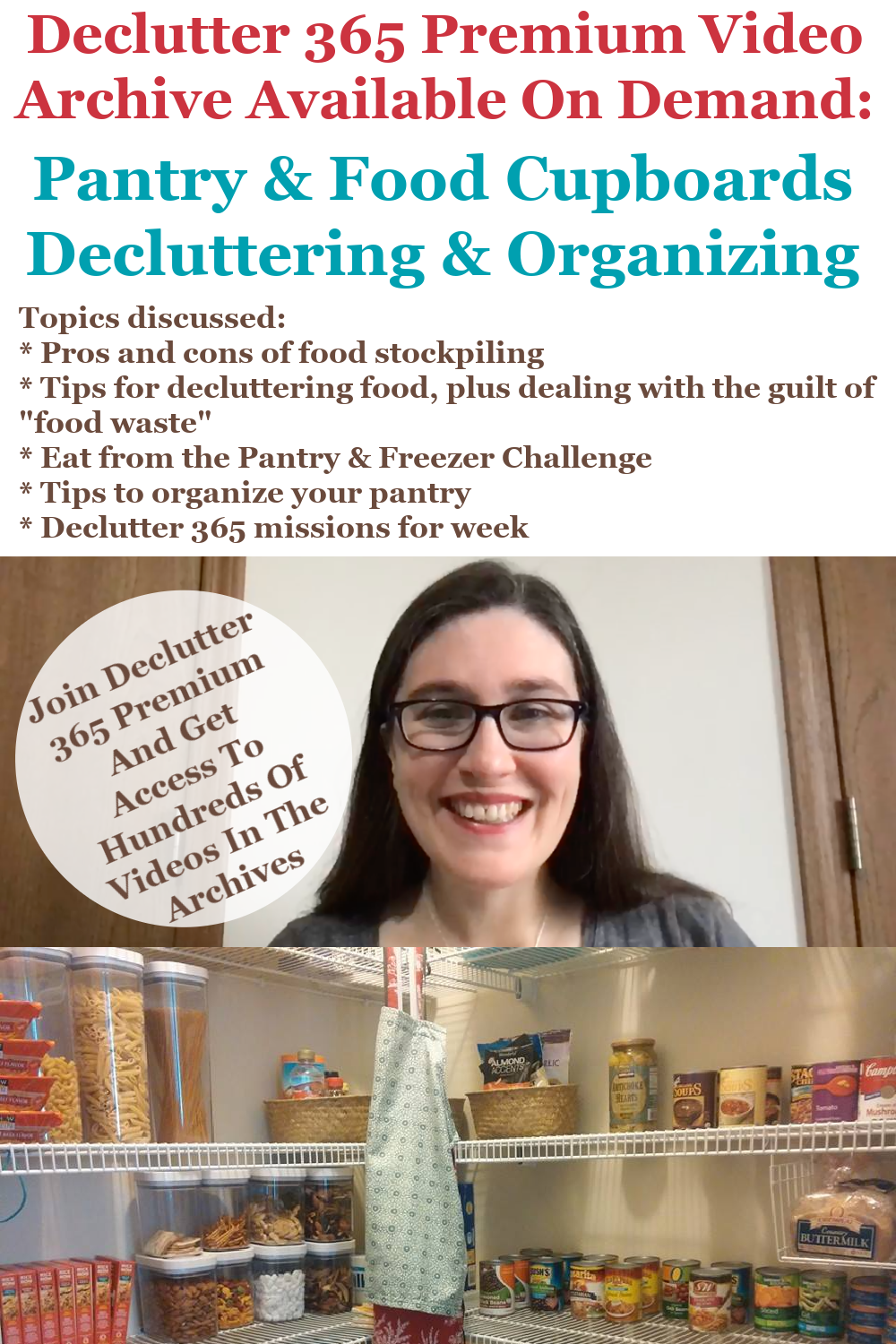
I suggest watching the video archive for the week, perhaps while you're doing some decluttering or cleaning around your home, before starting the week's missions and Challenge, and then you'll be able to breeze through this week's worth of decluttering missions, as well as organize what's necessary for the 52 Week Organized Home Challenge, based on the advice and instructions within those videos.
It really is like having me, Taylor, available, 24-7, as your decluttering and organizing coach, for every area of your home!
Plus, once you're a member of Declutter 365 Premium you get access to not only this video, but all the videos for the 52 weeks of the year, for 5 years (that's over 260 videos available in the archives!)

Get This Pantry & Food Decluttering Checklist + 32 Other Decluttering Checklists For Your Home
Right now you're decluttering your pantry and other food storage areas, and there's a lot of stuff to declutter in this space.
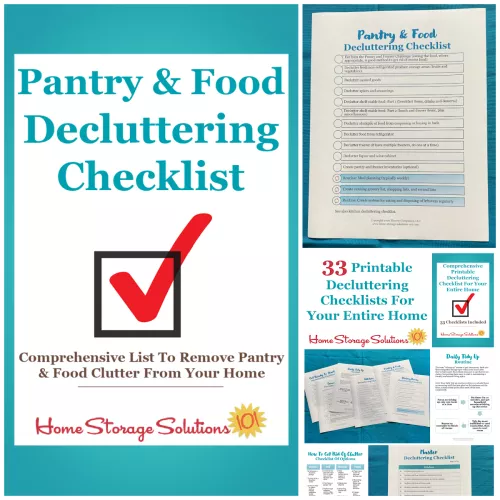
I've done the hard work of breaking down these tasks into smaller more manageable steps for you, so you don't get overwhelmed or worry you're forgetting a task, and you can go at the pace you want, whether that's fast or slow.
In addition, you can tackle these decluttering tasks in whatever order you want when you use these checklists!

Tell Me How The Organize Pantry, Spices & Food Challenge Is Going For You
I would love to know how this week's Organize Pantry, Spices and Food Challenge is going. You can tell me your progress or give me more ideas for how you've organized this area of your home below in the comments.
I also love before and after pictures of pantry organization, and would love to see some of yours. Submit your pictures (up to four per submission) and get featured in the Creative Storage Solutions Hall of Fame. You've worked hard to get organized, so now here's your chance to show off!
I know the challenge just started, but I've already got some before and after pics, so here's what I've got so far from other readers that might inspire you:
Sneak Peek For Next Week's Challenge
We're working on our homes slowly, one area at a time, so don't get too distracted from the Organize Pantry Challenge this week. However, I want you to know that we're focusing on one area of food storage this week, and waiting until next week to conquer cold food storage when we organize the refrigerator and freezer.
Since the kitchen needs so much organization and constant attention, because it is used so often, I've given us plenty of time to get it done.
Make Sure You Make The Most Of These 52 Organizing Challenges
Get your copy of the printable one page 52 Week Organized Home Challenge schedule for the year here, so you can see all the challenges we're working on.

Further, if you'd like to join a community of others who are all commmitted to these organizing challenges and corresponding decluttering missions, and want more interaction with me, Taylor, video archives of Taylor providing more tips for each of these challenges and missions, as well as live monthly group coaching sessions focusing on the skills and habits necessary to maintain your home from now on, I'd urge you to join the private and exclusive Declutter 365 Premium Facebook group (you can learn more about it at the link).
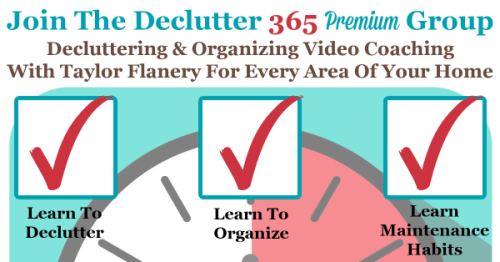
In addition, have you gotten your Declutter 365 Products yet, to make sure you can get even more assistance with decluttering and organizing your home this year? There are both free products (like the Declutter 365 calendar, a $20 value), as well as add-ons, such as daily text messages, planner stickers, and a Premium Facebook group, as well as a pack of printabe decluttering checklists.
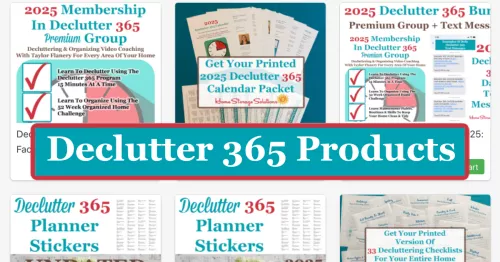
Cook Great Meals In Less Time With An Instant Pot: Free Course To Learn How
Do you have an Instant Pot hiding in your cabinet? Want to learn how to use it? Sign up for Instant Pot School! It's free, and it will help you put that time-saver to work!
Learn more about this free course, and why I'm recommending it in my article all about Instant Pot School.
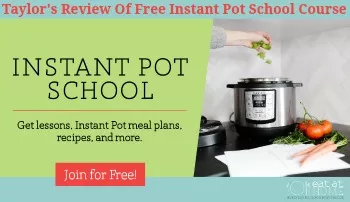
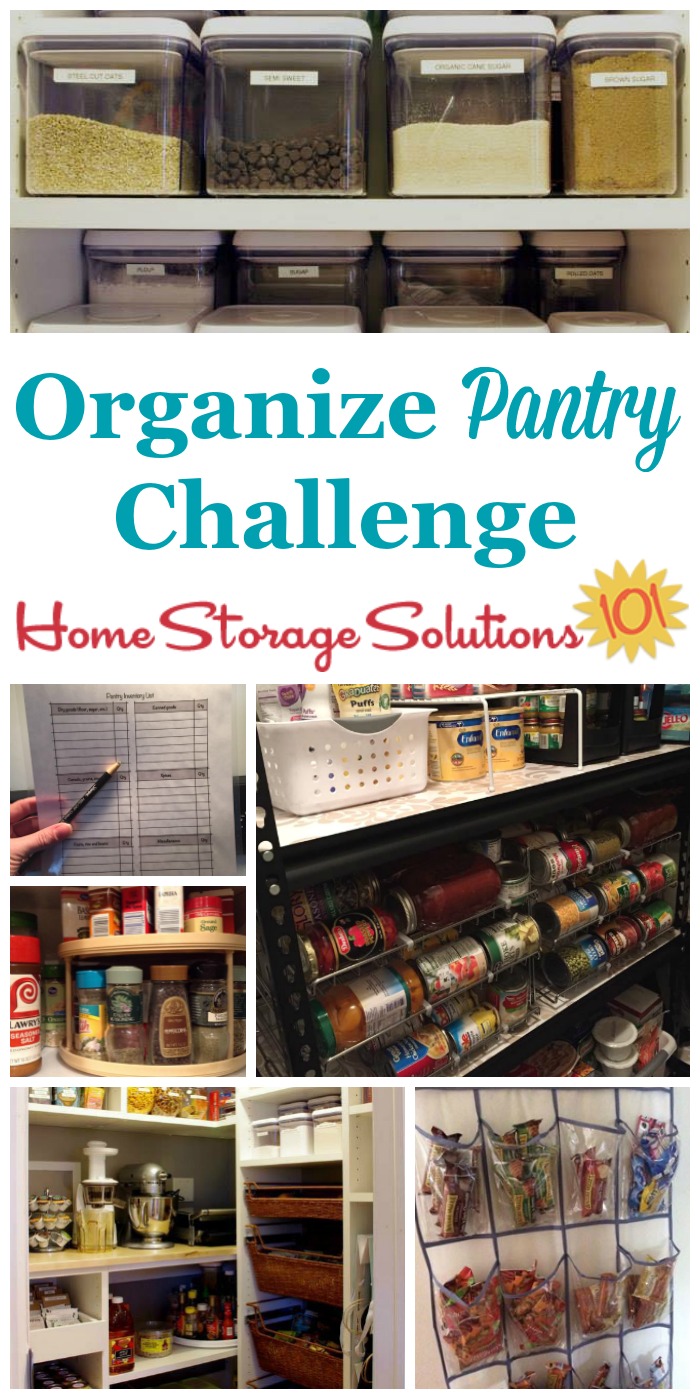
Top photo courtesy of a reader, Sunny
Some links on this page are affiliate links, meaning that if you purchase a product through them I receive a small commission which helps me provide this information to you for free, plus support my family. My integrity and your satisfaction are very important to me so I only recommend products I would purchase myself, and that I believe would benefit you. To learn more please see my disclosure statement.


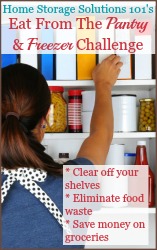
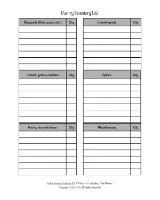


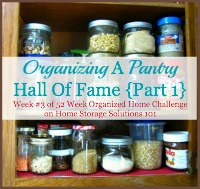
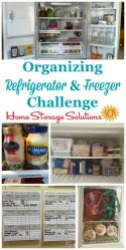
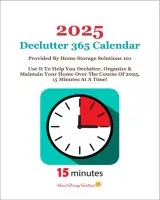
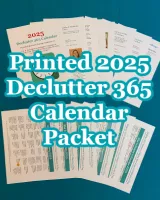
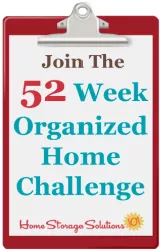



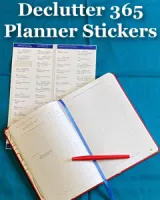




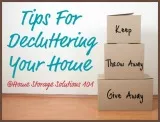
Share Your Comments, Tips & Ideas
I would love to hear from you, sharing your thoughts, questions, or ideas about this topic, so leave me a comment below. I try to always respond back!